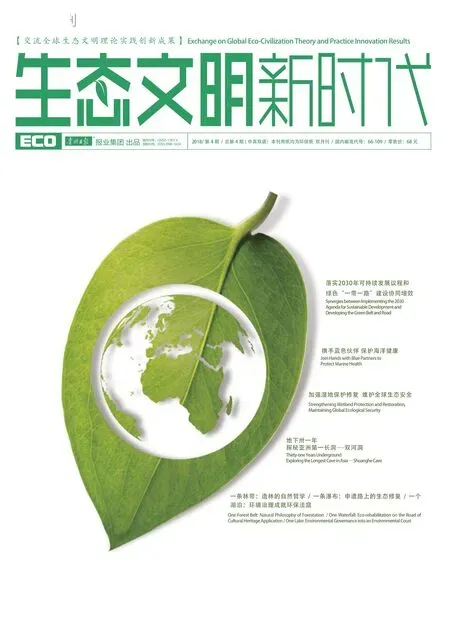攜手藍(lán)色伙伴 保護(hù)海洋健康
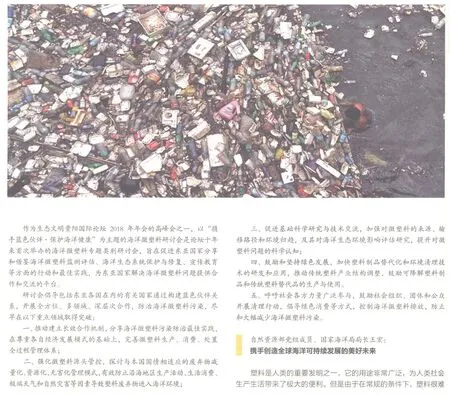
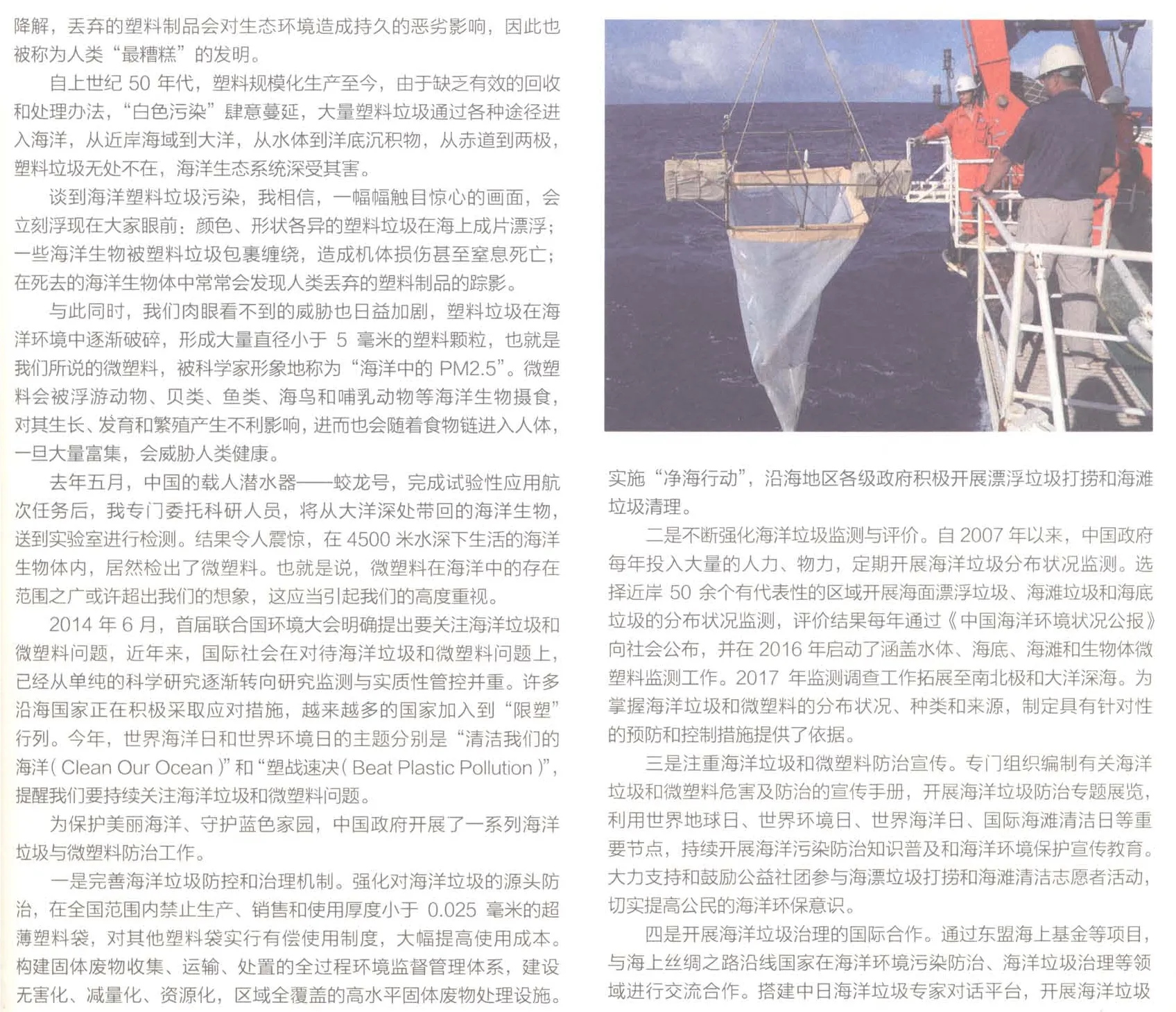
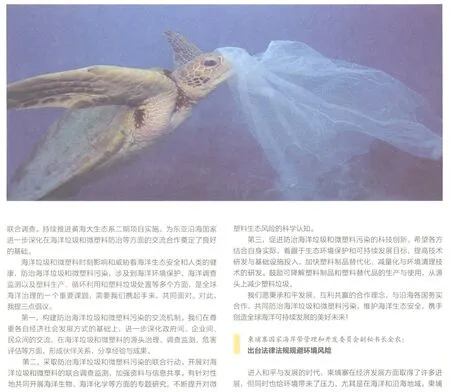
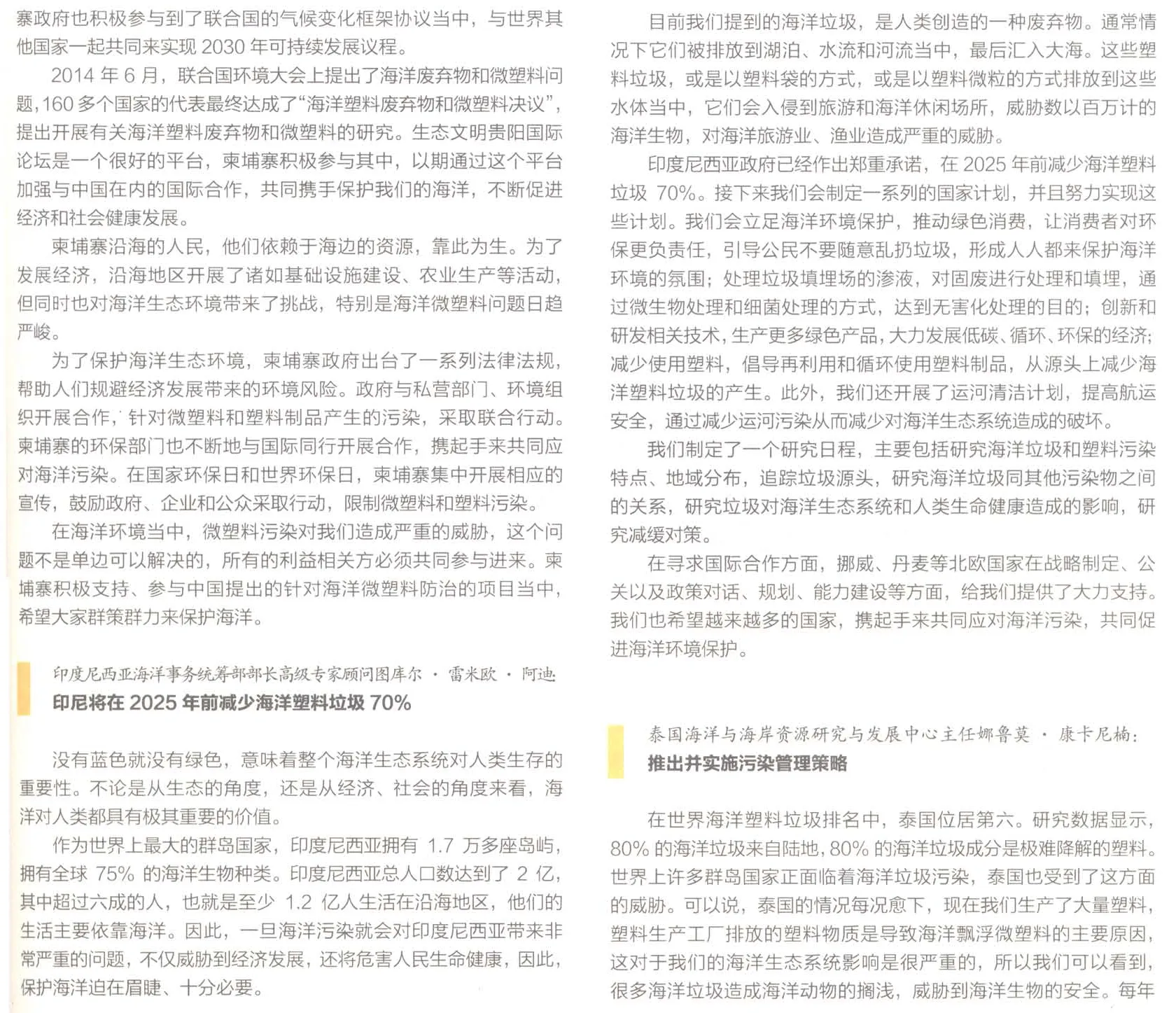
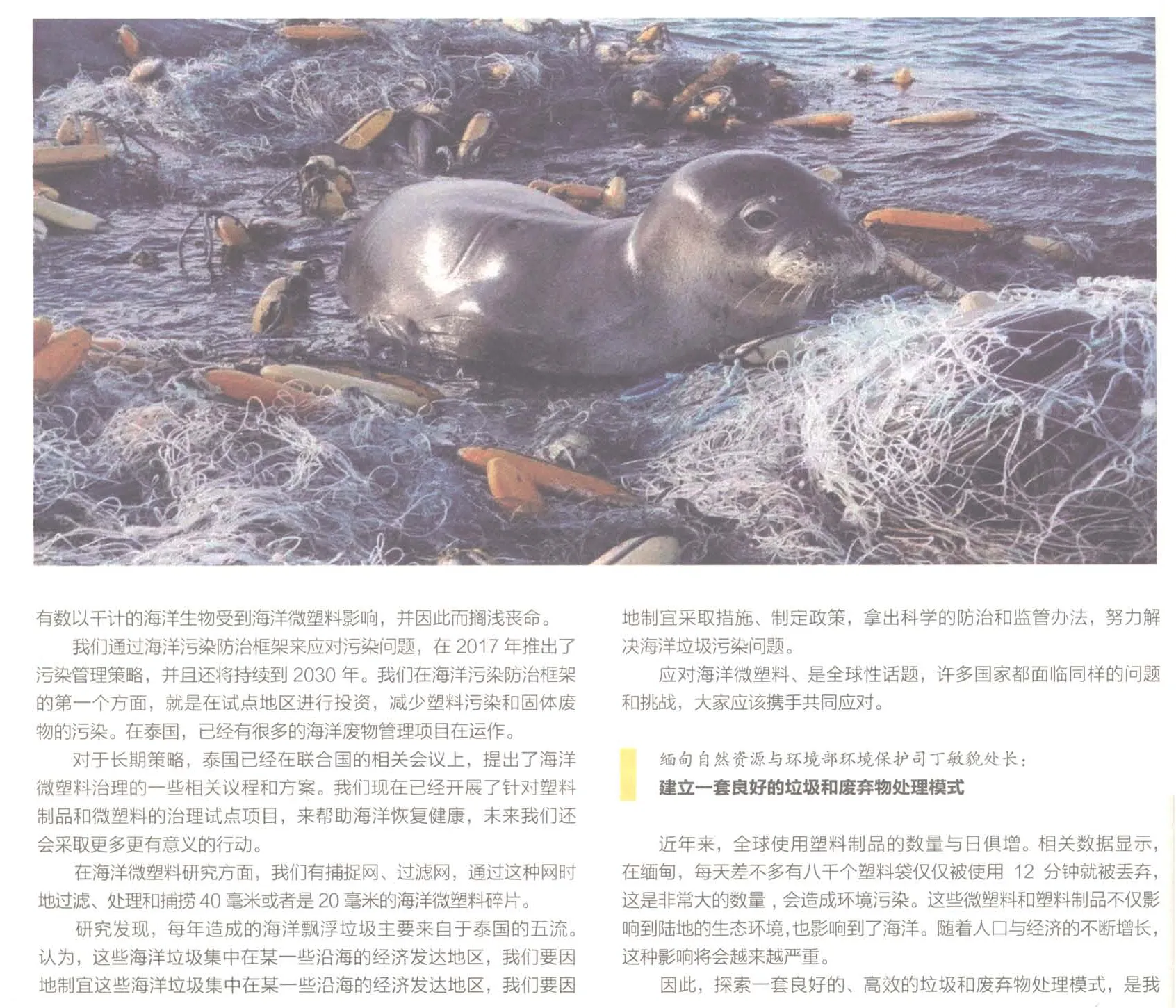

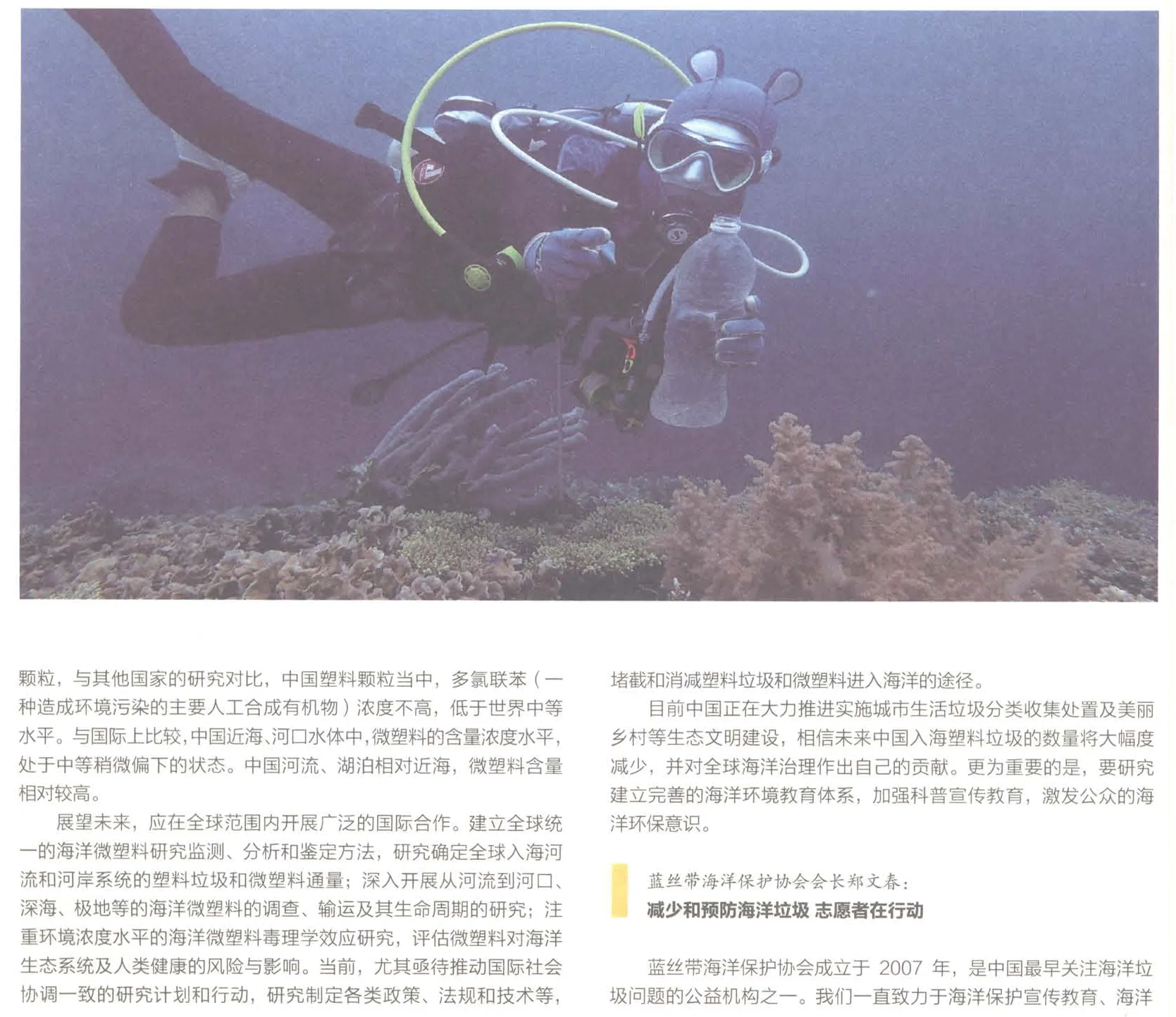
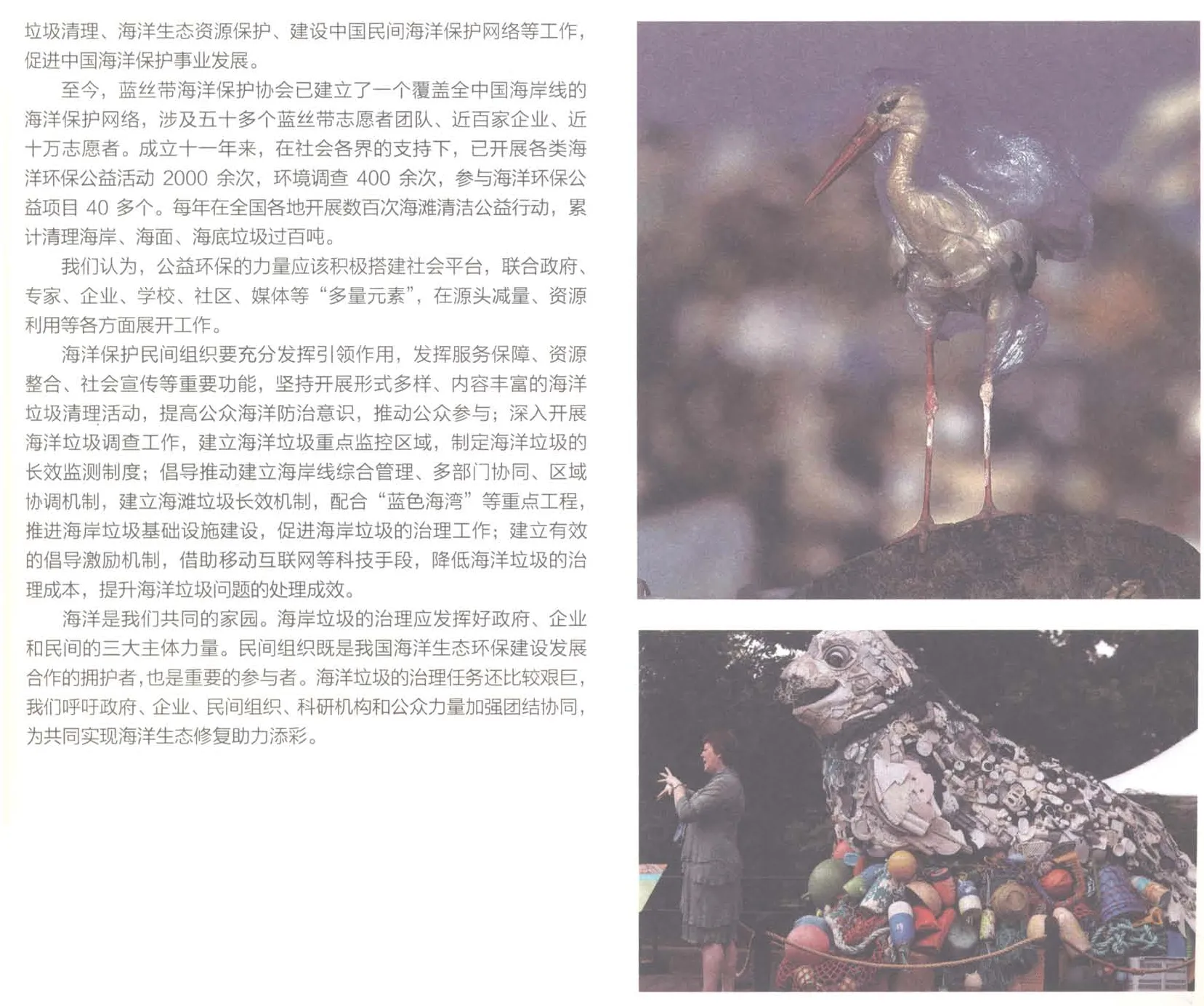
Join Hands with Blue Partners to Protect Marine Health
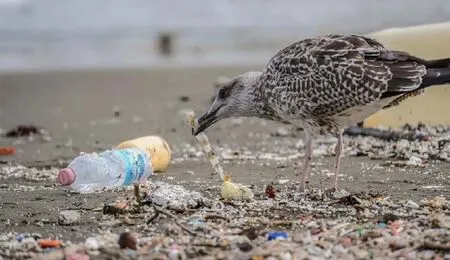
As one of the summits of Eco Forum Global Annual Conference Guiyang 2018, the Marine Microplastics Symposium themed “Join Hands with Blue Partners to Protect Marine Health” was held in Guiyang. As the first symposium on marine microplastics held by the forum in the past 10 years, it aimed to promote actions and best practices in the areas of marine microplastics monitoring and assessment, marine ecosystem protection and restoration, and promotion of education to facilitate cooperation and communication among countries of East Asia on marine microplastics.
The symposium advocated that relevant countries, including countries of Southeast Asia, carry out all-round, multi-field and in-depth cooperation through the establishment of the blue partnership to prevent and control marine microplastic pollution and make breakthroughs in the following key areas as soon as possible:I. Promote the establishment of a long-term cooperation mechanism to share best practices in preventing and controlling marine microplastics pollution, and improve the whole-process management system covering production,consumption and disposal of microplastics on the basis of respecting each other’s economic development models;
II. Strengthen source control of microplastics, explore a waste-reducing,recycling and harmless management model that is appropriate to China’s national conditions, so as to effectively prevent plastic waste from entering the marine environment due to production activities, living consumption, extreme weather and natural disasters in coastal areas;
III. Promote the exchange of basic scientific research and technology and strengthen the research on the source, transport path and environmental trend of microplastics, as well as its impact on the marine ecological environment, so as to improve the scientific understanding of microplastics;
IV. Encourage and adhere to green development, accelerate the development and application of plastics substitution and environmental cleaning technologies, promoting the restructuring of traditional plastics industries, and encouraging the production and use of biodegradable plastics and alternatives of traditional plastics.
V. Call on widely participation of all sectors of society and encourage social organizations, groups and the public to carry out clean-up actions, advocate green consumption and other means to control marine microplastics emissions and prevent and substantially reduce marine microplastics pollution.
Wang Hong, Member of Leading CPC Members Group of the Ministry of Natural Resources and Director of the State Oceanic Administration:Join Hands to Create a Better Future for the Global Marine Sustainable Development
Plastics products are one of the important inventions of human beings. It has a wide range of uses and brings great convenience to the production and life of human society, but plastics are difficult to degrade under normal conditions and discarded plastics can have a lasting and adverse impact on the environment, so they are also called the “worst” inventions of human beings.Since the 1950s when plastics were produced on a large scale, due to the lack of effective recycling and treatment methods, "white pollution" spread indiscriminately. A large amount of plastic waste has entered the ocean through various channels, from coastal waters to the ocean, from water bodies to ocean floor sediments and from the equator to the poles. Plastic waste is ubiquitous and causes serious damage to marine ecosystems.
When it comes to marine plastic waste pollution, I'm sure images will immediately come to your mind: plastic waste of different colors and shapes is floating in bulk pieces at sea; some sea creatures are wrapped in plastic waste,causing body damage and even death by suffocation; plastic waste discarded by human is often found in dead marine life.
At the same time, Threats that are invisible to the naked eye are growing, with plastic waste gradually breaking up in the marine environment, forming massive amounts of plastic particles less than 5 millimeters in diameter, known as microplastics, which is figuratively called by scientists as the “PM2.5 in the Ocean”. Microplastics are eaten by zooplankton, shellfish, fish, seabirds and mammals, which adversely affect their growth, development and reproduction, and then enter the human body along the food chain. Once abundant, they can also threaten human health.
In May last year, after completing the experimental application mission of
Jiaolong, China’s manned submersible, I specially commissioned scientific researchers to bring back marine life from the depths of the ocean to a laboratory for testing. The results were so shocking that microplastics were detected in marine life living at depths of 4,500 meters. That is to say, the presence of microplastics in the ocean may be beyond our imagination, which should be attached with great importance.
In June 2014, the first UN Environment Assembly clearly raised the issue of marine waste and microplastics. In recent years, the international community has gradually shifted its focus from purely scientific research to the combination of research, monitoring and substantive control of marine waste and microplastics. Many coastal countries are taking active measures, and more and more countries are joining the team of “Plastic Limit”. This year,World Ocean Day and World Environment Day, with their respective themes of “Clean Our Ocean” and “Beat Plastic Pollution”, reminded us of keeping an eye on marine waste and microplastics.
To protect the beautiful ocean and the blue homeland, the Chinese government has carried out a series of prevention and control work of marine waste and microplastics.
First, we have improved the mechanism for preventing and controlling marine waste. We have strengthened the prevention and control of marine waste at the source, banning the production, sale and use of ultra-thin plastic bags less than 0.025mm thick nationwide, imposing a system of paid use on other plastic bags, which has substantially increased the cost of using them. We have established a whole-process environmental supervision and management system for the collection, transportation and disposal of solid waste, and built a high-level solid waste treatment facility that is harmless, recycling and waste-reducing, covering all areas. We have carried out “Clean Ocean Operations”, and governments at all levels in coastal areas have actively carried out floating waste collection and beach waste disposal.
Secondly, we are constantly strengthening marine waste monitoring and evaluation. Since 2007, the Chinese government has invested a lot of manpower and material resources every year to monitor the distribution of marine waste on a regular basis. We have selected more than 50 representative regions near the shore to monitor the distribution of floating waste, beach waste and seabed waste. The evaluation results were published annually to the society through the Bulletin of China Marine Environmental Status, and the monitoring work covering water bodies, seabed, beaches and biological microplastics was launched in 2016. In 2017, the monitoring and investigation work was expanded to the Arctic and Antarctic and the deep ocean, which has provided a basis for understanding the distribution, types and sources of marine waste and microplastics and developing targeted preventive and control measures.
Thirdly, we have paid attention to the propaganda of marine waste and microplastics prevention. We have specially organized brochures on the hazards and prevention of marine waste and microplastics and conducted thematic exhibitions on marine waste prevention and control, continuing to disseminate knowledge on marine pollution prevention and marine environmental protection education by making use of such important nodes as Earth Day, World Environment Day, World Ocean Day and International Coastal Cleanup Day. We have strongly supported and encouraged public interest groups to participate in activities such as fishing for waste and coastal cleanup, which has raised the awareness of marine environmental protection among citizens.
Fourthly, we have conducted international cooperation in the management of marine waste. Through projects such as the China-ASEAN Maritime Cooperation Fund, we have conducted exchanges and cooperation with countries along the Maritime Silk Road in such areas as marine environmental pollution prevention and control and marine waste management. We have set up a dialogue platform between Chinese and Japanese marine waste experts and conducted joint surveys on marine waste. We have continued to promote the implementation of the second phase of the Yellow Sea Large Marine Ecosystem (YSLME), which has laid a good foundation for the coastal countries of East Asia to further deepen exchanges and cooperation in the prevention and control of marine wastes and microplastics.
Marine waste and microplastic affect and threaten marine ecological safety and human health at all time. The prevention and control of marine waste and microplastic pollution, which involves many aspects including marine environmental protection, marine investigation and monitoring as well as plastics production, recycling and disposal, is an important issue in global ocean governance. We need to join hands and face it together. I have three proposals as follows:
First, we should build an exchange mechanism to prevent and control marine waste and microplastic pollution. On the basis of respecting each other’s way of economic and social development, we will further deepen exchanges among governments, enterprises and people and form partnerships to share experiences and achievements in the areas of source control, investigation and monitoring, and hazard assessment of marine waste and microplastics.
Secondly, we should take joint action to prevent and control marine waste and microplastic pollution. We should carry out a joint survey and monitoring of marine waste and microplastics to strengthen information sharing as well as a targeted and joint research on marine biology, marine chemistry and other aspects, and constantly improve our scientific understanding of the ecological risks of microplastics.
Thirdly, we should promote technological innovation to prevent and control marine waste and microplastic pollution. We hope that all parties concerned would, in light of their actual conditions, focus on the goals of ecological environmental protection and sustainable development, increase investment in technology research and development and infrastructure, and accelerate the research and development of plastic products replacement, reduction and environmental cleanup technologies. We should encourage the production and use of biodegradable plastic products and plastic substitutes to reduce plastic waste at source.
We are ready to adhere to the concept of peaceful development, win-win cooperation and practical cooperation with coastal countries to jointly prevent and control marine waste and microplastic pollution, so as to maintain marine ecological security and jointly create a better future for sustainable development of the world's oceans.
Kim Nong, Deputy Secretary General of National Committee for the Management and Development of the Coastal Zone, Cambodia: Introducing Laws and Regulations to Avoid Environmental Risks
Entering an era of peace and development, Cambodia has made much progress in economic development, but it has also put pressure on the environment, especially in the oceans and coastal areas. The government of Cambodia is also actively involved in the United Nations Framework Convention on Climate Change (UNFCCC), working with the rest of the world to achieve the 2030 Agenda for Sustainable Development.
In June 2014, the UN Environment Assembly raised the issue of marine waste and microplastics, and representatives from more than 160 countries finally reached the "Resolution on Marine Plastic Waste and Microplastics",proposing to conduct research on marine plastic waste and microplastics. Eco Forum Global Guiyang is a good platform for Cambodia to actively participate in. Cambodia hopes to strengthen international cooperation with China and other countries through this platform to jointly protect our oceans and promote the healthy development of our economy and society.
People on the coast of Cambodia depend on the resources of the coast for their livelihood. For the sake of economic development, activities such as infrastructure construction and agricultural production have been carried out in coastal areas, but at the same time, these activities have brought challenges to the marine ecological environment. In particular, the problem of marine microplastics is becoming increasingly serious.
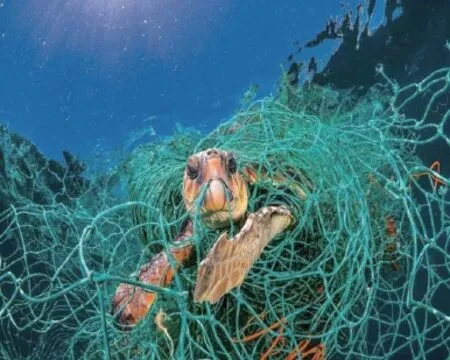
To protect the marine environment, the Cambodian government has introduced a series of laws and regulations to help people avoid environmental risks brought by economic development. The government has teamed up with the private sector and environmental groups to take joint action on pollution from microplastics and plastics. The Ministry of Environment of Cambodia has been working with international counterparts to tackle marine pollution.On National and World Environment Day, Cambodia focuses on corresponding campaigns to encourage governments, businesses and the public to take action to limit microplastics and plastic pollution.
In the marine environment, microplastic pollution poses a serious threat to us.This problem cannot be solved unilaterally, and all stakeholders must participate in it. Cambodia actively supports and participates in the prevention and control of marine microplastics proposed by China, and hopes that we could pool our efforts to protect the ocean.
Tu Kuer Leimiou Adi, Senior Expert Advisor to the Minister of Ministry of Maritime Affairs and Fisheries, Indonesia: Indonesia will Reduce Marine Plastic Waste by 70% before 2025
There is no green without blue, which means that the whole marine ecosystem is important to human survival. From the perspective of ecology, economy and society, the ocean is of great value to human beings.
As the world’s largest archipelago nation, Indonesia has more than 17,000 islands and is home to 75 percent of the world’s marine species. Indonesia has a total population of 200 million, of which more than 60 percent, or at least 120 million people, live in coastal areas that depend on the sea. Therefore,once marine pollution becomes a very serious problem for Indonesia, it not only threatens economic development, but also endangers people's lives and health. It is urgent and necessary to protect the ocean.
The marine waste we are talking about is a kind of waste created by human beings. Usually they are discharged into lakes, streams and rivers and eventually into the sea. These plastic wastes, either in the form of plastic bags,or in plastic particles discharged into these waters, will invade tourism and marine leisure sites, threatening millions of marine life, thus bringing serious threats to marine tourism and fishing.
The Indonesian government has vowed to reduce marine plastic waste by 70%before 2025. Next, we will develop a series of national plans and work to implement them. We will focus on marine environmental protection and promote green consumption, making consumers more responsible for environmental protection, and guiding citizens to avoid littering, so as to create an atmosphere where everyone can protect the marine environment. We will treat the seepage in the landfill and treat and fill the solid waste, achieving the goal of harmless treatment through microbial treatment and bacteria treatment.We will innovate and develop relevant technologies and produce more green products, vigorously developing a low-carbon, circular and environmentally friendly economy. We will reduce the use of plastic and promote reuse and recycling of plastic products, reducing the generation of marine plastic waste at source. In addition, we have launched a canal cleaning program to improve shipping safety and reduce damage to marine ecosystems by reducing canal pollution.
We have developed a research agenda, which mainly includes studying the characteristics and geographical distribution of marine waste and plastic pollution, the tracking of the source of waste, the relationship between marine waste and other pollutants, the impact of waste on marine ecosystem and human life and health, and mitigation strategies.
In seeking international cooperation, Norway, Denmark and other Nordic countries have provided us with strong support in strategic development,public relations and policy dialogue, planning and capacity building. We also hope that more and more countries will join hands to tackle marine pollution and promote marine environmental protection.
Nanomin Kangkanilan, Director of Marine and Coastal Resources Research and Development Center, Thailand Launch and Implementation of Pollution Management Strategies
Thailand ranks sixth in the world’ ranking of marine plastic waste. The statistics show that 80% of marine waste comes from land, and 80% of marine waste is made of plastics that are extremely difficult to degrade. Many
archipelagic countries around the world are facing pollution from marine waste, and Thailand is also under threat. You could say that Thailand is going from bad to worse. Now we produce a lot of plastics, and the main cause of floating microplastics in the ocean is the production of plastics from factories,which has a serious impact on our marine ecosystem. Therefore, we can see that a lot of marine waste causes the stranding of marine animals, which threatens the safety of marine life. Each year, thousands of marine life are affected by marine microplastics and thus stranded to death.
We address pollution through the marine pollution prevention framework. A pollution management strategy was launched in 2017 and will continue until 2030. The first aspect of our marine pollution prevention framework is investment in pilot areas to reduce plastic pollution and solid waste pollution.There are already a number of marine waste management projects operating in Thailand.
For the long-term strategy, Thailand has put forward some relevant agenda and programs for the management of marine microplastics at relevant meetings of the United Nations. So far we have launched a pilot program for the governance of plastics and microplastics to help our oceans come back to life, and more meaningful actions will be taken in the future.
In the study of marine microplastics, we have fishing nets, filter nets, through which we can filter, process and catch 40 or 20 millimeters of marine microplastic fragments 24 hours a day. The study found that the floating trash generated in the oceans each year mainly comes from five rivers in Thailand.We have found that these marine wastes are concentrated in some economically developed areas along the coast. We need to take measures,formulate policies, put forward scientific prevention and control measures and strive to solve the problem of marine waste pollution.
Dealing with marine microplastics is a global topic, and many countries face the same problems and challenges. We should work together.
Tin Min Miaung, Chief of Environmental Protection Division, Ministry of Natural Resources and Environmental Conservation, Myanmar: Establishing a Set of Good Trash and Waste Disposal Pattern
In recent years, the number of plastic products used worldwide has been increasing. Statistics show that people use a single plastic product and discard it after an average of 12 minutes. In Myanmar, almost 8,000 plastic bags are used every day, which is a very large number and causes environmental pollution. These microplastics and plastic products affect not only the ecological environment of the land, but also the sea. As the population and economy continue to grow, the impact will be more and more severe.
Therefore, it is an urgent task for us to explore a set of good and efficient trash and waste disposal pattern. If this problem is not solved, it will affect our rivers,waterfalls and even the environment of the whole country. If trash and waste are increasing and are not treated properly, many plastic products will be buried in the soil, which will then produce toxins that spread to the ecosystem for recycling. We must change the production and use of plastics, and the government must develop policies to address this problem at source.
In order to solve the problem of waste pollution, the Myanmar government has formulated corresponding action plan in accordance with the sustainable development goals of the United Nations. The main principles are green,clean, sustainable and environmentally friendly, so as to build a better Myanmar. At the same time, our country has also cooperated with relevant countries in addressing climate change and waste management.
The production of plastic products by private enterprises should first consider whether they are easy to degrade, recycle and reuse, and should take into account both the business model innovation and the marine ecological environment protection.
Zhu Shuang, Expert in the Ecosystems Division of United Nations Environment Programme (UNEP) UNEP Supports Efforts to Tackle Marine Microplastics
Global plastics production and the plastics industry have been developing rapidly, with the total output of plastics reaching 8.3 billion tons, of which 6.3 billion tons have become waste. Total plastic production reached 322 million tons in 2015, which is up 50% from 2002.
Microplastics are everywhere. In a study, 29 bottles of water were randomly collected from the surrounding waters of different countries, including Mexico, the United States and Thailand. Only 17 samples were free of plastic pollution, and the average microplastics in the remaining samples was as high as 325 pieces. The study found that traces of marine microplastics can be found in sea salt, beer, honey, fish and tap water, and even in the sea ice of Antarctica in abundance. According to the EU survey, consumers absorb an average of 11,000 microplastic fragments a year.
We need a global, binding international agreement to deal with the problem of marine waste. At present, the United Nations Convention on the Law of the Sea (UNCLOS), the Convention on Biological Diversity (CBD) and the Stockholm Convention on Persistent Organic Pollutants have been formed,providing a legal framework for addressing issues related to the ocean,stipulating the obligation of countries to protect and maintain the marine environment, which can be used for the regulation of marine waste.
The UNEP regional marine projects have successfully organized and implemented regional marine waste activities around the world. It has adopted legally binding regional marine protection instruments to assess the status of marine waste in various regions, prepare action plans for regional marine waste management, and organize participation in International Coastal Cleanup activities.
The UNEP is strongly supporting and helping many countries to analyze the current status of marine waste, formulate corresponding “road map” and“action plan” to deal with marine waste problem. At the same time we also put forward a series of policy suggestions and a series of best practice cases for relevant regions, countries and supervision authorities to help them find better ways to cope with the problem of microplastic pollution.
Li Daoji, Director of Plastic Marine Debriss Research Center, East China Normal University: Concentration of Microplastics in Coastal and Estuary Waters in China at a Lower Moderate Level
In the past decade, international organizations, academia and the public have made great progress in discussions of marine plastic waste and researches on marine microplastic pollution. Global production of plastic products reached a staggering 335 million tons in 2016, and is still growing.
The environmental risks of marine plastic waste caught scientists’ attention in the 1970s. Marine microplastics have primary and secondary sources.However, to our surprise, there is still insufficient understanding of marine microplastic waste and microplastics sources. Research methods have not been unified and standardized, and research efforts and measures to deal with this new threat to marine environment are quite different in different regions of the world.
So far, relevant research of marine microplastics in China has covered all aspects of possible research areas, including the abundance of microplastics in various habitats, analysis methods, biological accumulation, toxic effects,microbial degradation, and pollution control and management of microplastics.

The Ministry of Science and Technology and the National Natural Science Foundation conducted more than 20 studies involving marine microplastics in 2015 and 2017. In 2016, the Ministry of Science and Technology launched the national key research and development program, the marine microplastics pollution monitoring and ecological environment effect assessment technology research project, which has achieved many research results and had a great impact at home and abroad. This research project has made important progress in the following aspects: complete the draft technical regulation of marine microplastics monitoring in China and carried out operational trial; reveal the composition and quantity distribution of microplastics in China’s coastal waters; establish the digital model of microplastics transport in Bohai Sea,Yangtze River Estuary and East China Sea; reveal the characteristics of marine microplastics pollution in the coastal waters of China; establish the prediction model of the plastic waste yield in China; initially construct the marine microplastics pollution ecological risk assessment method; complete the survey on production of plastic products and plastic waste pollution control and so on. At present, there are nearly 30 research units in China, which are carrying out research on microplastics pollution of water bodies, organisms,sediments, atmospheric food and so on, covering land, sea, coast, ocean and polar regions.
In 2016, the State Oceanic Administration monitored the distribution of marine microplastics in China's coastal waters. The monitoring results showed that the average density of microplastics in surface waters offshore eastern China was about 0.29 per cubic meter, the highest density of microplastics near the Yangtze River estuary was 2.35 per cubic meter, and the density of microplastics on the beach was between 100 and 1,200 per square meter.
As one of our concerns, we analyzed marine plastic particles collected from beaches. Compared to other countries, among Chinese plastic particles,
polychlorinated biphenyls (a major synthetic organism causing environmental pollution) are not at high concentrations, which are below the world average.Compared with the international situation, the concentration level of microplastics in coastal and estuary waters in China is moderate and slightly lower and the content of microplastics in rivers and lakes are relatively high.
Looking ahead, extensive international cooperation should be carried out on a global scale. A globally unified method for the monitoring, analysis and identification of marine microplastics research should be established to study and determine the plastic waste and microplastics fluxes of the global sea-going rivers and riverbank system; in-depth studies on the investigation,transportation and life cycle of marine microplastics from rivers to estuaries,deep oceans and polar regions should be carried out; studies on the toxicological effects of marine microplastics with environmental concentration level should be focused and the risks and impacts of microplastics on marine ecosystems and human health should be assessed. At present, it is particularly urgent to promote coordinated research plans and actions of the international community to develop policies, regulations and technologies to block and reduce the access of plastic waste and microplastics to the sea.
At present, China is making great efforts to promote ecological civilization construction, such as classified collection and disposal of municipal solid waste and beautiful countryside. It is believed that the amount of plastic waste entering the sea will be greatly reduced in the future and China will make its own contribution to global ocean governance. More importantly, it is necessary to establish a complete education system for marine environment, so as to strengthen the popularization of education and arouse the public’s awareness of marine environmental protection.
Zheng Wenchun, President of the Blue Ribbon Ocean Conservation Association: Volunteers of Marine Waste Reduction and Prevention on the Move
The Blue Ribbon Ocean Conservation Association, founded in 2007, is one of the first public welfare institutions concerned with marine waste in China. We have been committed to promoting marine protection, such as educational popularization, marine waste disposal, marine ecological resources protection,and building China's civil marine protection network, so as to promote the development of marine protection in China.
So far, the Blue Ribbon Ocean Conservation Association has established a marine protection network covering the whole coastline of China, involving more than 50 blue ribbon volunteer teams, nearly 100 enterprises and nearly 100,000 volunteers. Over the past 11 years, with the support of all sectors of society, it has carried out more than 2,000 public interest activities on marine environmental protection, conducted more than 400 environmental surveys,and participated in more than 40 public interest projects on marine environmental protection. Every year, it carries out hundreds of public interest actions on coastal cleanup across the country, and accumulates over 100 tons of coastal, surface and undersea waste.
We believe that the power of public welfare and environmental protection should actively build social platforms, and work together with “Multiple Elements” such as governments, experts, enterprises, schools, communities and media to reduce resources at source and make use of resources.
A non-governmental organization of marine protection should give full play to their leading role and their important functions such as service guarantee,resource integration and social publicity, persist in carrying out marine waste cleanup activities in various forms and rich contents, raising public awareness of marine prevention and control, and promoting public participation; it should carry out in-depth surveys of marine waste and establish key monitoring areas for marine waste and a long-term monitoring system for marine waste; it should promote the establishment of a mechanism for comprehensive coastal management, multi-sectoral coordination and regional coordination and establish a long-term mechanism for coastal waste, cooperating with key projects such as “Blue Bay”, pushing forward the construction of coastal waste infrastructure, and promoting the management of coastal waste; it should establish an effective incentive mechanism and use technological means such as mobile Internet to reduce the cost of managing marine waste and improve the effectiveness of the disposal of marine waste.
The oceans are our common home. The management of coastal waste should give play to the three main forces including the government, enterprises and the public. Non-governmental organizations are both advocates and important participants of China’s marine ecological and environmental construction and development cooperation. The task of managing marine waste is still relatively difficult. We call on the government, businesses, non-governmental organizations, scientific research institutions and the public to strengthen unity and collaboration to contribute to the common efforts of marine ecological restoration.
sented by green technology innovation and technology spillovers. Because

